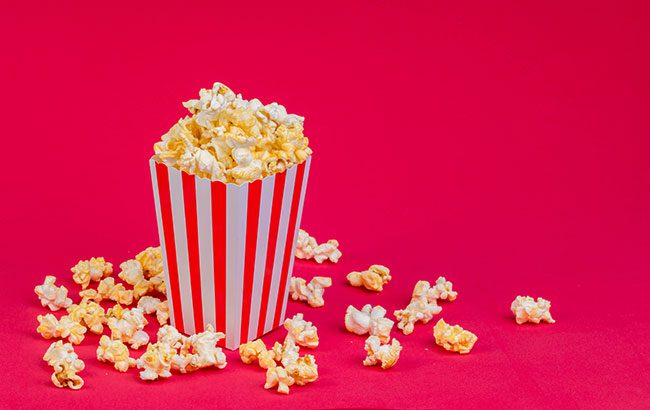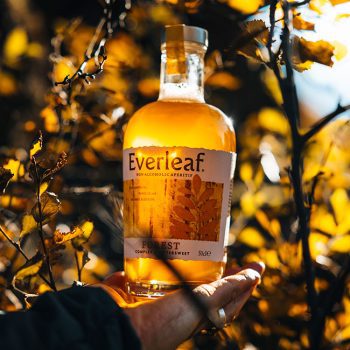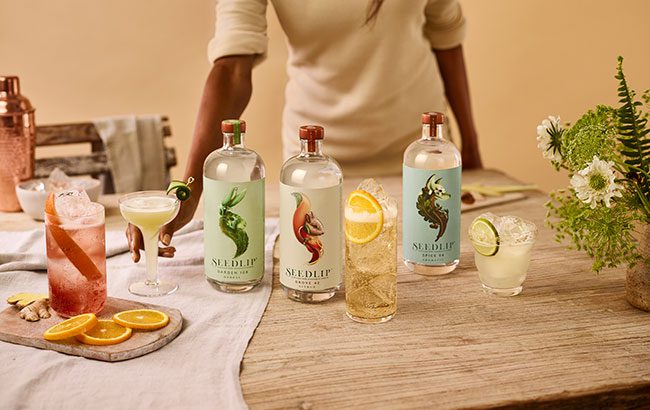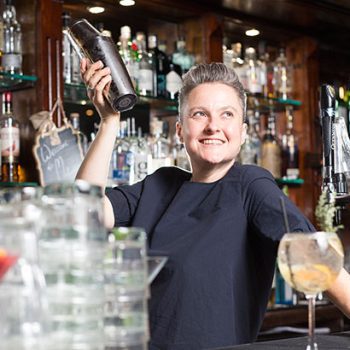Popping off: how are brands elevating low and no?
By Claire DoddThe low-and-no movement has well and truly started, but now it’s time to take it to the next level. The question is, how? We explore how brands are elevating the category.

*This feature was originally published in the February issue of The Spirits Business magazine.
What does it feel like to create a category? “What feels most surreal is that I still feel like it’s just getting started,” says Ben Branson, whose 2015 launch of Seedlip helped birth what is now often referred to as the low-and-no movement.
A decade in, it has enjoyed an impressive rise. There are thousands of brands worldwide in a category that has diversified from an initial flurry of direct alcohol replacements to unique standalone liquids, functional brands, ready-to-drink offerings, mid-strength options, and beyond.
“Back in 2013 to 2015 when I was creating Seedlip,” adds Branson, “you could get a Becks Blue and Kaliber and that was it, that was what we had. Everyone was drinking lime and soda. To go from that to a US$20 billion category, according to Euromonitor, with well over 1,000 brands, this whole ecosystem… is really incredible.”
Rising demand
If there were ever doubt, demand is now proven. The overall no- and low-alcohol segment almost doubled from 2022 to 2023, with volume growth of 47%. While the UK is expected to see 1% volume and value declines in the total beverage alcohol market over the five years from 2024, according to IWSR Drinks Market Analysis data, conversely low and no is set to grow. Compound annual growth rate volume is forecast to grow a further 19% from 2023 to 2028. If that happens, it will add £800 million (US$1bn) incremental value to the category.
Yet, for all the milestones and landmark achievements, there’s a real sense across brands, retailers and key stakeholders that this is a category still in its infancy. “One thing we’ve definitely got right is there is an enormous amount of passion and energy and dynamism, creativity and willingness for this category,” adds Branson. “But we’ve obviously got a huge spectrum of quality in terms of liquids, and, sadly, the majority aren’t good, or aren’t good enough. Every time a bad product launches, somebody will have a bad first experience of this category, and they might not come back.”
So where do we go now? How does the category continue to recruit drinkers? And how are brands working to elevate the low-and-no space now that demand for it seems certain?
“People are using a different part of their brain when they buy an alcohol-free drink,” says low-and-no expert Laura Willoughby MBE, founder of the mindful drinking movement, Club Soda. “This is something the alcohol industry has to get used to, and has never tapped into before. They’re making a health-spending decision, not just a socialising-spending decision. We have moved a long way in terms of range and quality of product, availability of product, and then, most importantly, our cultural attitudes towards not drinking.”
She adds: “But there has been an over-reliance on clear ‘spirits’ and gin-style ones, and that needs to diversify a bit more. There’s a long way to go. And the shape of what’s popular is shifting.”
Mainstream awareness

Functional drinks have long been touted as a potentially vast subsegment. Innovation so far has been led by brands including Three Spirit, and Kin Euphorics. But mainstream awareness is yet to take off.
“Functional and nootropic products are innovating in a way that has not really been possible before to deliver wellness benefits or a more natural change of state effect without alcohol,” says Heidi Dillon, CEO of Distill Ventures. The drinks incubator has long backed a number of non-alcoholic brands including Seedlip and best-selling US non-alcoholic ‘spirits’ brand, Ritual Zero Proof.
“The non-alcoholic sector is fascinating in its ability to innovate and create entirely new segments, unrestricted by the production, legislation, or expectations that shape the alcohol industry,” she adds. “These trailblazing brands are carving out new spaces in the market, delivering products that challenge conventional definitions and bring fresh perspectives to what drinking occasions can look like.”
Mood-enhancing brand Smiling Wolf, which launched in autumn 2024, is perhaps the buzziest new name on the functionality block. Blending nootropics and vitamins intended to give imbibers both an uplift and a sense of contentment, the alcohol-aligned range includes Aperitivo, Dry London, Agave, Vodka, and Cane. Could its unusual combination of mood-altering ingredients and alcohol-aligned flavours mark a bold push towards broadening consumer awareness of functionality?
For Melanie Masarin, founder and CEO of Ghia, the challenge remains to move away from the constraints of alcohol conceptually, linguistically and practically. The spirits-free apéritif brand launched in the US in 2020, and now includes Le Fizz with strawberry and orange blossom, and the ready-to-drink Le Spritz range in flavours including Lime & Salt, Ginger, and the culinary-leaning Sumac & Chili. Europe is a target for future expansion. The first words that you see when you log on to its website are: “It’s not a mocktail, it’s Ghia.”
“The non-alc market in the US has completely transformed over the past few years,” says Masarin. “What used to feel niche now feels like a movement. It’s not just about the product anymore – it’s about how people engage with it, from the rituals they create to the stories they share over a Spritz.
“So much of the focus is still on the fact that these drinks don’t have alcohol, instead of celebrating what makes each product great. I’d love to see the conversation shift to flavour, craftsmanship, and the joy of sharing something thoughtful and intentional.”
Category conundrum
Defining the category in negative terms – as a non-thing, as what it isn’t, rather than what it is – remains a conundrum. So too is how to best boost the category’s presence and visibility, from where it should be stocked to how it should be listed on a menu. Research released in January by Everleaf with data provider KAM found that though 98% of venues offer at least one alcohol-free drink, visibility on menus or at the bar remains poor; 52% of customers say they have to “actively” search for them. “[Non-alc] is becoming more an ingrained part of the drinks industry, which is exactly as it should be,” adds Everleaf founder Paul Mathew.
He says that even Dry January has shifted instead to year-round interest, with peak sales months now aligning with full-strength in November and December. “I hope to see that represented in drinks lists where alcohol and non-alcohol are mixed up. And it’s not that section of shame or page of shame at the back of a cocktail list. Customers are looking for it; we have to make it easy to find it.”
He adds: “I’d love to see drinks that don’t happen to have any alcohol in them being regarded as just the same as all the other drinks on the bar that do. We’ve always wanted Everleaf to be just a good drink, not a good non-alc. As more brands come to market, hopefully we’ll see that.”

Branson similarly feels the time is now for non-alc liquids to stand on their own. Not content with launching one paradigm-shifting liquid, he’s set about creating another. Launched as part of his Pollen Projects venture, Sylva is described as the world’s first non-alcoholic dark ‘spirit’ distillery and sonic-maturation laboratory with a focus firmly on flavour and craftsmanship.
Debut product Padauk launched in September 2024. In a marked change for non-alc spirits, it’s designed for sipping and uses four wood species (red oak, white barrel oak, olivewood, and padauk).
“It’s a luxury product,” says Branson. “The purpose of Sylva is twofold. There’s an aspirational opportunity to be able to sip something neat that’s dark and non-alcoholic. People don’t know what an aged, non-alcoholic spirit tastes like. That ‘slow down, sit down, take a moment’ opportunity in non-alc is wide open and totally under-leveraged. We’ve sort of hit all those codes without trying to imitate Scotch, rum, Cognac or other dark spirits. There isn’t really a dedicated, dark non-alc liquid brand that’s an expert or just focused on that.
“Second, there are 73,000 tree species on this planet. Bar white oak, which is used to make 99% of the barrels on the planet, I don’t think we know anything about what wood tastes like. The flavour of wood is unexplored. That’s really exciting.”
The brand has hit the ground running. A new Sylva lab is set to open in upstate New York this summer, with Kyoto, Japan, to follow in early 2026. Each lab will create its own distinct, localised products. The idea is for no single product to be repeated.
“This is the worst silver liquid that I will make,” says Branson of Padauk. “I am 100% sure of that. That may sound strange, but ultimately we’ve invented a process. That’s been both immensely frustrating and annoying, but also incredibly exhilarating and rewarding. And we’re only at the beginning.”

Another company at the start of its non-alc journey is Scottish firm William Grant & Sons. In September 2024 it launched its New to World & Non-Alcohol division, led by Ciara McDevitt. It follows – after quite a pause – the 2019 launch of its only non-alcoholic ‘spirit’, Atopia, a liquid created by Hendrick’s master distiller, Lesley Gracie. Is the producer late to the party?
“William Grant as a company, we’re more go slow and get it right, than wanting to be the first mover and jump on a trend,” says McDevitt. “I feel good about our timing. In terms of the category, we’re only just off to the races. The shotgun has just gone off in terms of reach and consideration for the normal punter on the street. Everyone’s a potential moderator, everyone’s a potential consumer of non-alcohol. We are coming in at the right time where consumers are more accepting, and are more focused on taste.”
She adds that the next six months are critical for the company to plan its next launches and reinvestment in Atopia, amid rapidly changing consumer behaviour.
McDevitt agrees that the focus must be on taste. “We’re determined to win the taste race,” she adds. “The way the consumer is evolving, there are more stories to be told, and there are new and more interesting ways to communicate around it. We want to be part of it, but we want to do it in a way that’s true to who and what we are.
“We have such extraordinary talent in Scotland, creating the most wonderful liquid. So it really feels like we’re going to do something amazing.”
Industry insights
New research suggests the on-trade is ‘behind the curve’ when it comes to alcohol-free options. Do you agree?
Godelief van Erve – global marketing director, De Kuyper Royal Distillers
“Yes. The demand for alcohol-free drinks that offer a special experience is growing, with many embracing hybrid-drinking. There should be no compromise on taste or presentation when experiencing a non-alcoholic option. Hospitality professionals can elevate alcohol-free cocktails by giving them the same care as alcoholic ones: beautiful garnish, proper glassware, and great presentation.
“At De Kuyper, we are advancing the 0%-alcohol category by offering non-alcoholic pre-mixed cocktails for our on-trade partners that deliver the same great taste as alcoholic ones. We also think that it is crucial for alcohol-free cocktails to have a dedicated space on menus, reflecting their growing importance and appeal.”
David Murphy – vice-president product and quality, Lyre’s
“There is great opportunity for venues to capitalise on the momentum of the no-and-low category. In the UK, a third of pub visits are now alcohol-free, providing a new occasion for publicans to capitalise on spend per head in venue and drive customer satisfaction by catering to new customer preferences.
“Building a no- and low-alcohol menu is often as simple as understanding which cocktail options work well in venues, and creating a similar offering in no and low by using non-alcoholic alternatives such as Lyre’s Non-Alcoholic, and supplementing with non-alcoholic beer and wine options. Listing no-and-low options on menus drives uptake and accessibility.”
Anita Osborne – sales and marketing manager EU/UK, Lyre’s
“Recent research indicates that the UK’s on-trade sector is lagging in meeting the growing demand for alcohol-free options. While 98% of venues offer at least one non-alcoholic drink, their visibility on menus and at the bar is often lacking. Notably, one-in-three pub visits is now alcohol-free, highlighting a significant shift in consumer preferences. To stay relevant, it’s essential for venues to enhance their alcohol-free offerings, ensuring they’re prominently featured and readily available to guests seeking quality alternatives.”
Eugenio Muraro – founder and CEO, MeMento
“I agree that the horeca (hotels, restaurants, cafés) sector is not aligned with the customer market’s growing need for non-alcoholic products. I attribute this to two main reasons that can be traced back to the same topic, which is culture and education about non-alcohol. I say this because, first of all, the salespeople who sell products are generally experts who have always worked with spirits or wines, and therefore with alcoholic products.
“On the other hand, there is a lack of specific staff training on the part of distributors and wholesalers that can properly promote and valorise all aspects of non-alcohol products dedicated to mixology. In conclusion, there is a need to communicate and train, above all those in the trade, because they are often the first ones not to be updated on new products and the needs of customers, but want to sell what they are used to without renewing themselves.”
How important is the on-trade in helping low-alcohol brands become more established?
Chantal Thalmann – head of event and Trojka, Distillerie Willisau
“The on-trade is vital for establishing low-alcohol brands. It’s where consumers first experience these products in a social setting. Bartenders act as authentic ambassadors, driving trial and education through well-crafted serves. Beyond awareness, the on-trade builds credibility – premium venues elevate perception and highlight versatility. Bars and restaurants are trend incubators, shaping consumer behaviour and creating a ripple effect for off-trade demand. From collaborative events to menu placements, the on-trade is the launch pad where low-alcohol options gain traction, connecting with consumers in a way that no shelf can replicate. It’s not just about visibility – it’s about creating moments that matter.”
Related news
Low-and-no takes off in APAC bars
